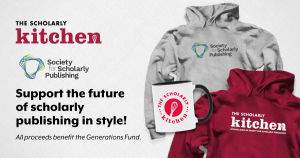Managing Director, NISO
 First, tell us a bit about yourself (hometown, current locale, family, hobbies, community involvement?).
First, tell us a bit about yourself (hometown, current locale, family, hobbies, community involvement?).
I grew up in Rochester, NY, along the shores of Lake Ontario; a lovely city six months out of the year. The other six months are snow-filled and gray. The snow I miss, the overcast less so. In the early 90’s I moved to Maryland, working for a time in DC, and eventually moved into Baltimore City, which is where I now call home. My fiancé and I have an 20-month-old son, who keeps me busy and entertained when I’m not working. In addition, I am an avid photographer, focusing mainly on abstracts and patterns in the world. I try to keep active with skiing in the winter, and kayaking, mountain biking, and hiking in the summer. I also probably spend too much time with technology, which is where the line between work and play gets fuzzy.
What is your current job? Describe some of your responsibilities, and how you or your organization fit into the scholarly communications web.
Currently, I am the Managing Director of the National Information Standards Organization (NISO). NISO plays a critical role in the information distribution supply chain through the development of standards relating to identification, description, discovery, exchange, preservation, sales, collection, and management of media in analog and digital format. NISO works both on the national (ANSI) and international (ISO) levels to create standards and best practices. NISO has played a leading role in the development and deployment of highly recognized standards in the publishing world such as the ISBN, ISSN, DOI, Dublin Core, OpenURL and COUNTER. More recent, NISO has focused on digital information exchange in projects like SUSHI, KBART, ERM systems, and metadata standards.
What career path led to your current position?
It seems that most of my colleagues have great stories about how they ended up in publishing. I have only met a few people who started out with life plans to be in scholarly publishing, but almost all are very pleased with their life choices.
I followed my sister to Syracuse University, where I studied German and Philosophy, possibly the least practical dual degree imaginable. After college, I left the north for the warm environs of Atlanta, where I went from working for Lufthansa to the German-American Chamber of Commerce. After a few years enjoying the warmth, I left and moved back north to Binghamton, NY and got my first job in publishing as a marketing coordinator for The Haworth Press. I started out researching promotional outlets and mailing lists for catalogs. Shortly thereafter, the first browser was launched and I began using the internet to solicit journal subscriptions. I worked from home because the office didn’t yet have an internet connection. My responsibilities also included developing marketing tracking and inventory database systems, which got me involved in technology and analysis.
After a few years at Haworth, I moved to Maryland and began working with a news service that covered the oil and natural gas industries, the Energy Intelligence Group. The company was formed after a merger of two esteemed publications and I spent the first year working on integrating circulation, finance and marketing systems. My other main responsibility was for marketing the publications. It was an amazing time as we moved the company from daily print distribution to email and eventually web-based delivery of information.
In 1998, I moved back into the scholarly publishing world where I took a position at the Journals Marketing Manager at the Johns Hopkins University Press. My team was responsible for promotion of subscriptions to the Press’s 55+ academic journals, advertising sales and journal title acquisition. At the time, JHU Press was rapidly expanding its online journal platform, Project Muse. Shortly after I joined the Press, Muse began providing service to other university presses and non-profit publishers. The entire Muse management team worked to forge new ground in publishing, addressing questions of licensing, sales and revenue distribution models, and the balance between print and online publishing.
In 2004, I left the press to join another online journal aggregation service, BioOne and took on the role of Director of Business Development, in which I focused on sales, business relationships, and development models. As a relatively new and rapidly growing service, BioOne was adjusting to the shift by libraries and users away from print toward online subscriptions. Balancing these revenue streams for participating publishers was a critical aspect of our work and where we spent a great deal of time.
Now as Director of NISO, I focus on standards, information technology and the exchange of information between publisher and vendor, supplier and library, and eventually to the end user. Each of these exchanges is a friction point where standards are needed to facilitate the delivery of content.
For the past decade, the majority of companies and initiatives that I have worked on have straddled this line between our different communities, publishing, suppliers and libraries. How each part interacts with and engages the others and their interaction that keeps our world interesting.
Where do you see scholarly communications heading, and what new directions interest you most?
The publishing world generally is in the midst of tremendous change, the likes of which haven’t been seen since the mid-19th century or possibly the age of Gutenberg and movable type. This has been repeated so much, it’s almost cliché. However, it is difficult to underestimate the impact these changes will have on our community over the next several decades. Those of us who are active in scholarly publishing will be addressing these issues for the rest of our careers.
I see the following as critical areas that are in most desperate need of attention in our community: discovery, license and ownership questions, and preservation. On the questions of discovery, thanks to Google, we seem to have forgotten all of the advances in organization that libraries have developed over decades in finding information and have turned to rely solely on keyword searching. This works well enough 80% of the time. The problem is that people have become satisfied with the 80% results that Google returns in fractions of a second, not understanding that there may be something critical in that remaining 20%. Incorporating into search classification structures, ontologies, and improved semantics—all common under different guises in the print world—is a critical component to ensuring that ALL relevant content is visible to users.
There is much to be written about copyright and ownership questions with digital content. The same attributes that make sales of digital content so profitable for publishers also make the sharing and re-distribution of that content such a problem. How we as a community deal with these issues will be an area of much contention for decades.
Finally, preservation of the content we are creating is among our biggest challenges. No one much worried about the preservation of printed texts, because writing on paper (if well stored) can last hundreds or thousands of years. Digital information can disappear in the blink of an eye, or more likely become obsolete because of media or technology changes. While initiatives like Portico or LOCKSS address this question for some content, they are only limited to the content participating in those programs. There is a wide swath of digital information we are apt to lose, such as blogs, Facebook pages, twitter streams, online notebooks, or non-printed research reports that don’t end up in repositories that will likely go dark in future decades. Much of the current research on historical figures relies on their notes, letters and diaries to round out the story of their lives and activities. Today much of that is now online and prone to loss.
The directions that interest me most include ebooks and display technology, identification of items, people and content, and copyright. The next transformation of our industry will likely be in how people access digital content—moving away from the desktop to something that more resembles the experience of using a book. Much of this will depend on developments with display technology, digital ink, and battery power. How people interact with content is going to come down to better solutions for identification of people and content. Control of access to content will be driven by advances in identity management. This likely won’t come out of the publishing world (more likely banking or government), but will have incredible ramifications on how scholarship and all content is distributed. Finally, sharing and reuse of content is not likely to be contained by the current rules for copyright. Restructuring those rules to acknowledge and allow what most people want to do with content will be a key question worth watching if copyright is to continue to have any respect by end-users of content.
What advice would you give to people interested in a career in scholarly communications? What new roles or opportunities do you see emerging in the field?
I would suggest finding ways to proactively search for projects of interest, get involved and be willing to volunteer to contribute in the areas that you are interested in. You’ll find that many projects need additional people and resources, both within and outside of your current organization.
Find ways to get involved in a broad range of things. We are often hemmed in by our particular responsibilities, but developing knowledge of the other “links in the chain” is important. You might find new things you didn’t know you were interested in, but more likely you’ll develop a better understanding of how what you do impacts the rest of the chain of information—which it certainly does.
I see there being increasingly important opportunities, particularly for applying or improving technology in our workflows. As our entire industry become digitally based, understanding that technology is certainly a growth opportunity for careers in all aspects of publishing and libraries. I also see a strong future in many of the formerly print-based skills that need translation into a digital environment, such as cataloging, editing and indexing, which ties to my point above about getting away from the reliance on keywords for everything. Finally, there is a tremendous need for project management in our industry, which brings people from different organizational areas or companies to work on a joint project. How to bring people together and get them working on joint projects has always been critical in business. I see it becoming increasingly so because the strength in digital distribution lies in its scale and diverse application.
Profiled April 2009

